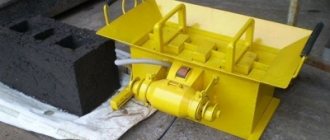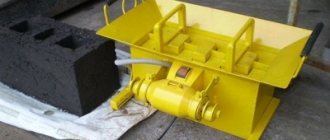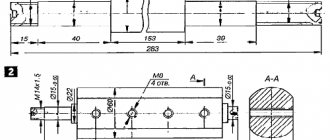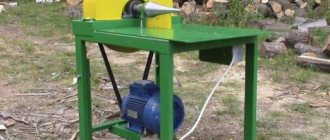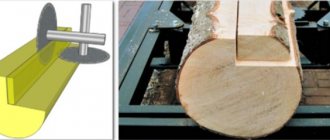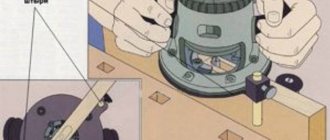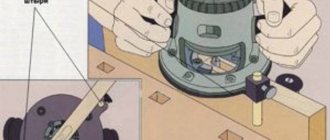Depending on your skills, experience, available tools and materials, you can make different versions of wood splitters with your own hands.
Some designs are quite simple and do not require much time and effort to assemble. Others are more thorough, and not every beginner can cope with such tasks.
So that everyone can find the best option for themselves, it is worth considering several of the most popular homemade wood splitters.
Crowbar cleaver
In terms of DIY assembly, a crowbar splitter is the simplest option for a wood splitter.
It works on the basis of the energy obtained from hitting the cleaver with a heavy object. Imagine an ax placed on a log. And a strong blow is made to the butt of the ax using a sledgehammer. The principle of a manual wood splitter is the same. But, unlike an ax with a sledgehammer, a cleaver is more convenient to work with, and the productivity of such a tool for harvesting firewood is higher.
Among the advantages of this type of wood splitter design are:
- high level of security;
- easy to make with your own hands;
- compactness;
- quick transition from one log to another;
- the user keeps his back straight when working, which helps with large volumes of chopping;
- there is no need to bend over before each log.
But there are also disadvantages. This mainly includes the need to use physical force, as well as loud noise during operation. So it’s worth getting ear protection in advance.
Structurally, a crowbar splitter as a homemade wood splitter consists of 2 components;
- cleaver and guide pipe;
- shock part.
The latter can be external or internal. In the first case, the impact part grips the guide pipe. And in the second it goes inside this pipe.
To make the crowbar cleaver truly functional and effective, it is important to follow the key rule. The point is to make the striking part as heavy as possible and the blade as light as possible. Just remember that the striking part will have to be lifted manually. The efficiency of a log splitter will increase as the difference in mass between the two components increases.
We can give several recommendations regarding the assembly of such a wood splitter:
- Try to maintain sufficient stroke of the striking part to create a large force when chopping wood. The optimal stroke length is 50-60 cm.
- To make the cleaver easier, use a thin-walled pipe to make a guide. Try to use a blade that is thin but strong.
- The problem of vibrations when working with a crowbar can be solved by making wooden handles rather than metal ones. If the handles are made of metal, then they should be welded to the most massive impact part. This will also help minimize vibrations.
- Install a polypropylene pipe between the working elements. This will make the ride smoother and also reduce noise from metal parts hitting each other.
Already in the process of chopping wood, try to use an old tire. A log is placed inside it and then a blow is struck. This way, pieces of wood will not fly around. Plus it is safer and more convenient when preparing large quantities of firewood.
Characteristics of product parameters
The tool is selected depending on the required parameters. These include:
- Weight . On the one hand, the heavier the cleaver, the faster the log will split. However, with prolonged work, fatigue sets in faster. Therefore, the mass is selected in accordance with the physical capabilities of the person. The weight range of the cleaver is in the range of 2−5 kg.
- Blade shape . The standard option is wedge-shaped. It is used most often. But there is also an eared species. They can only chop dry logs. It can get stuck in wood with a high degree of moisture.
- . Handle material The main material is wood, which has the ability to absorb vibrations from impact. However, the wood splits during the process. The material used as a replacement for wood is fiberglass. It is much lighter, and in terms of strength characteristics it is close to metal.
- Handle length . Depending on it, the impact force increases.
Spring log splitter
Another option on how to make an effective wood splitter with your own hands. This design will be somewhat more complicated. It is based on a spring.
As in the previous case, we are talking about a do-it-yourself mechanical wood splitter. That is, physical effort will be required. But not the same as for the crowbar splitter. In terms of complexity, it is superior to the crowbar-cleaver, but it wins in terms of efficiency.
When chopping logs, the force will be directed downwards. This actually takes the stress off your back completely. Here, the power of the blow will be influenced to a greater extent not by the physical strength of the person, but by the mass of the cleaver used.
The disadvantage is its large size and weight. Plus, the design of the wood splitter is considered more dangerous. Although in this component it is definitely not superior to a regular ax. Plus, each log will have to be delivered separately to the instrument.
The operating principle is based on the fact that the blade strikes the wood due to the impact of a large mass. The user only needs to unbalance the wood splitter's shoulder. In other words, move the cleaver blade down, which, due to the force of inertia, will do the rest of the work on its own. The spring ensures the return of the working element to its original position.
It is not recommended to assemble a wood splitter yourself without drawings. Therefore, prepare diagrams for assembling the structure in advance.
If you want to make a homemade mechanical spring log splitter with a gearbox with your own hands, it is important to take into account several key points:
- You can take any pipes. But it is important that they have sufficient structural rigidity. Otherwise, the wood splitter will not be able to perform its functions for a long time.
- Often a thick-walled pipe 40x60x6 mm is used as a basis. But it can be replaced with 2 pipes with thinner walls, but welded together.
- The force of the impact will directly depend on the weight of the moving structural element. The higher the mass of the cleaver, the greater the energy from the strike.
- The weight for the cleaver can be assembled from any heavy metal elements. Here, look for what is at your disposal. It is optimal if the cleaver combined with the load weighs about 50-60 kilograms.
- Choose your spring responsibly. Pay attention to its power. The spring should be enough to hold the arm of the splitting mechanism in a horizontal plane. Therefore, you need to correctly determine the correspondence between the mass of the cleaver and the compression force of the selected spring.
- If the force of one spring is not enough, take another one, but with a smaller diameter. It is inserted inside the main spring. Springs from cars are considered a good option. These are parts with a diameter of about 110 mm and a height of 450 to 550 mm. When the working element of the wood splitter is positioned horizontally, the spring will be compressed and its height will decrease to approximately 300 mm.
- Use an adjustable arm to achieve the desired balance between the weight of the cleaver and the load, as well as the spring.
Assembly is carried out using a welding machine, as well as bolted connections.
Use high quality materials. It is strictly forbidden to use rusted pipes or old springs as a basis. This version of the wood splitter is quite dangerous in itself. And the use of second and third grade materials will only increase the degree of risk when working with a wood splitter.
Difference from a regular ax
A splitting ax is much more convenient for chopping wood. It has a long handle (the so-called ax handle), the heavy blade is wedge-shaped, and its heavy weight and special shape promise to never get stuck in a wooden block.
The cleaver may look like a large hammer or sledgehammer with a pointed side, or it will be lighter and have protrusions-ears on both sides. Most often, the ax handle is made from birch, elm or maple wood.
Screw electric wood splitter
If you take an electric home wood splitter, which you can make yourself, then this option is rightly considered the easiest to assemble. Therefore, the design is deservedly popular.
The operating principle is relatively simple. The logs will be split using a conical screw that has a large thrust thread. The screw is screwed into the wood, which helps it split into pieces.
The downside is the energy consumption of the device, since the unit will operate using electricity. If you compare it with a splitting crowbar and a spring wood splitter, it will be more difficult to manufacture.
Structurally, the electric screw wood splitter consists of:
- conical threaded screw;
- electric motor;
- gearbox;
- chain or belt with pulleys.
Another big disadvantage is the increased risk of injury to the wood splitter. So you need to work with it extremely carefully.
If the torque is not enough, the screw may simply jam in the log. So it’s also important to choose the components for assembly wisely.
Many people are considering the option of a wood splitter using an old chainsaw. But the chainsaw itself is necessary for harvesting logs. Therefore, disassembling and converting it into a wood splitter is not the best idea.
As for an electric screw log splitter, the primary task is to ensure sufficient torque on the screw. There are several options to consider here:
- Powerful engine. The design will be based on a high-power electric motor. For such tasks you will need a motor of approximately 5-7 kW. The downside is that the electric motor will be quite expensive in terms of electricity consumption. But it will provide the required level of torque.
- Heavy flywheel. A large mass makes it harder to start the engine. But with this approach, the likelihood of the cone jamming in the tree is much lower. As the flywheel spins, it acquires greater kinetic energy. It takes a lot of force to stop the rotation. If you take a heavy flywheel, then it will be enough to install a 2-3 kW motor. The flywheel is mounted on the electric motor shaft, and not in the intermediate shafts of the chain or belt.
- Gearbox. An alternative solution would be to use a gearbox, belt or chain drive. This way you can reduce cone speed and also increase torque. At the same time, a chain drive is better than a belt drive. Although we cannot exclude the possibility of slippage from the sprocket or chain. A profitable and rational solution would be an electric motor of low power, but with high speeds. Approximately 3000 rpm. By reducing the speed of the gearbox or chain drive by 5 times, in parallel the torque on the cone of the wood splitter will increase to the same extent.
The chain and belt drive are selected so that the cone makes about 500-700 revolutions per minute. If the speed is higher, then there is a high probability of the log being pulled out of your hands. And this significantly increases the risk of injury to the wood splitter.
The distance from the table to the tip of the cone should be 70-100 mm. If you make it higher or lower, it will negatively affect the quality, efficiency and ease of splitting firewood.
A plate is welded directly under the cone. It is needed so that the log does not rotate when fed to the working rotating tool.
When working with an electric screw splitter, it is important to follow several key safety rules:
- do not use gloves, as the fabric may catch on the wood splitter and pull your hand in;
- make sure that there are no laces or belts hanging from clothing;
- install a large button or an emergency stop pedal on the unit;
- if it is a machine with a flywheel, not only the motor must stop, but also the shaft itself;
- logs are served exclusively in a vertical position.
You should not ignore safety precautions, since a wood splitter of this type is one of the most dangerous devices.
Working with a handheld device
First, the largest deck is selected on which the log is placed. It is advisable to chop lumps with a low degree of humidity. Dry logs weigh less. Each block falls into 2-8 parts. If the log is large, small parts break off from it on the sides, and then it is split in half.
Before starting work, the wood should be dried. If the weather is frosty, it is better to let the tree freeze so that the looseness and softness disappear from it. If there is a crack in the log, you should try to hit it with the tip. You can put a cleaver on it and hit it with a sledgehammer from above. If the metal is stuck in the wood, you should strike it hard with the butt of the cleaver on the block, first turning it over in the air.
Electromechanical wood splitter with gearbox and pusher
Very massive design and energy-consuming. Assembly requires substantial financial investment. A prerequisite is a powerful gearbox. The main advantage is increased productivity compared to the previous screw version.
The work is based on the use of a connecting rod mechanism. The gearbox rotates this connecting rod. He, in turn, slides along the guide towards the knife. Due to the gearbox, a large force is created. It is enough to split any wood.
To assemble the structure, you will need to make the right choice in favor of a suitable gearbox, motor, and pulley diameters. The length of the crank plays an even bigger role.
Regarding the choice of gearbox, motor and pulleys, the following recommendations can be given:
- You can use a gearbox that has a gear ratio of at least 1 to 20. But it is optimal to take one with a ratio of 1 to 40 or higher.
- The gearbox you choose must be able to withstand high torque without breaking down. And here the diameter of the output shaft will play a big role. Choose this indicator from 40 mm or more.
- The number of revolutions on the shaft should be about 11-14 per minute. To obtain such parameters, an engine with a rotation speed of 950 rpm and a gearbox with a gear ratio of 1 to 70 are required. The output then turns out to be 13.5 revolutions per minute.
- If the engine and gearbox have different characteristics, then to solve the problem you can use an additional belt drive between them.
- The engine power must be 3 kW and above. For a weak motor, you can install a flywheel on the shaft. Then the probability of the working element stopping due to lack of torque will be noticeably lower.
- Use a durable metal frame. Channel 12 or similar rolled metal is suitable for it. Otherwise, the likelihood of deformation and separation of the gearbox from the frame increases.
- Make the knife on the basis of hardened hard steel. Alternatively, it could be 65G spring steel. It is used to create flat springs.
An equally important point is the selection of crank length. The stroke length of the pusher will depend on it. The log splitter parameter is selected based on the size of logs you plan to chop using the equipment.
If the logs are about 40 cm long, then the pusher should have a stroke of 40 cm. The pusher does not reach the knife by 4-5 cm. It turns out that the maximum distance between the log splitter knife and the pusher will be approximately 44-45 cm.
The length of the crank is selected 2 times less than the stroke of the pusher. In the case considered, this is 20 cm. This will be the distance between the centers of the two shafts of the wood splitter. Many people underestimate the importance of crank length selection. But the lower this indicator, the more force the pusher ultimately creates.
A big mistake many of those who assemble such wood splitters with their own hands is creating tight contact between the connecting rod and the knife. There is practically no gap. And this absolutely cannot be done. The minimum recommended gap is 5 cm. Even if the connecting rod does not reach the knife, the log will still split. Plus, this is a guarantee that if your hand gets into this gap, you will not get injured. The user of the log splitter will have a margin of 5 cm to preserve the integrity of his own hand.
Rack-and-pinion electromechanical splitting device
This mechanism is one of the most productive.
The idea is to attach the movable knife to the gear rack. The latter moves due to the work of gears.
But in terms of self-assembly, the design is very complex. Here you will need a set consisting of:
- gear rack;
- gear;
- flywheel, etc.
An option for professional use when you need to process a large number of logs. Therefore, this wood splitter is not suitable for home use.
